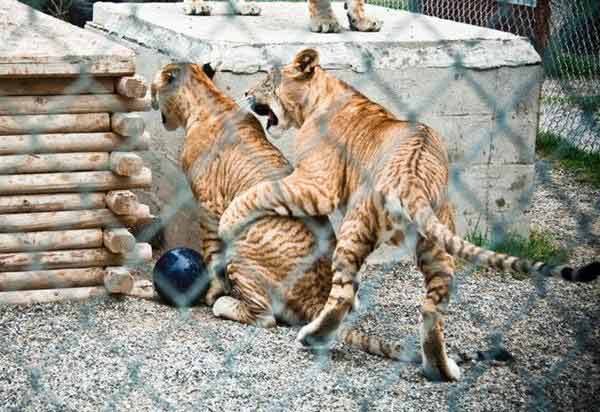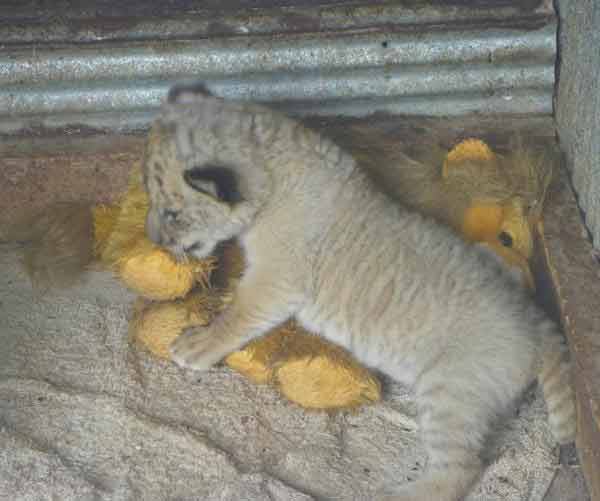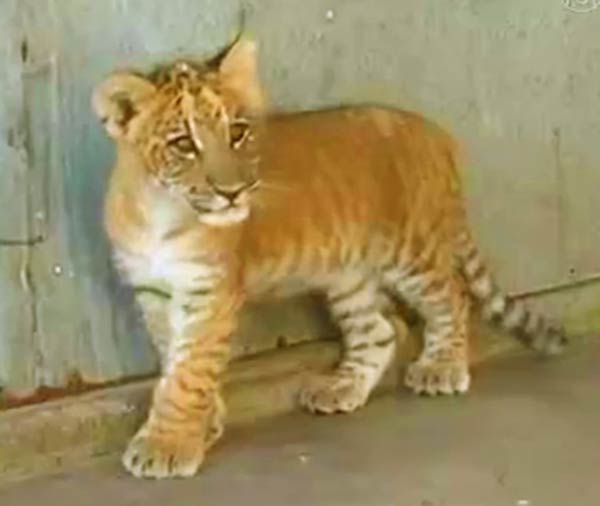Liger Cubs and Mortality Rates
Mortality rates of the liger cubs can provide very important information for the success or the failure of the liger breed. There is no firm evidence that most of the ligers actually die, whenever, they are born. Some online sources have speculated this fact for the personal gains, whereas; others have simply blind-foldly followed it. Liger experts have opposite opinion and these opinions are backed with the fact which specifically prove that mortality rates of the liger cubs is not such as an issue as it is propagated by some propaganda campaigners.

In China, there have been a lot of focus on the cross breeding of the lion and the tiger to produce liger. The same is true about United States as well which has the highest numbers of ligers in the world right now. Mortality rates of the new born liger cubs can provide significance evidence that whether the ligers as a species are prone to mortality. Either an evidence from China or United States can be highly reliable to measure the mortality rates of the liger cubs. So in this observation we shall include sample of the liger cubs from China as well as from United States of America.

A tigress gave birth to a liger named as Zao Zao during 2004, but the liger died after 50 hours. The same tigress gave birth to four liger cubs at the same time but one of the died, while the rest of the three survived. Since 2004, this tigress has given birth to about 12 ligers, only 2 of them have died while the ramining 10 ligers are even still alive as of today. Another tigress during 2002 gave birth to another liger in the Hongshan zoo in Nanjing. That liger died just after a week. That was the first ever liger cub being born in China. In 2002 again another tigress in the Fozhou province gave birth to a liger which lived around 100 days or approximately three and a half months. So the mortality rates of the liger cubs is there but it is not that much huge as it has been propagated as a negative propaganda.

These above observations do indicate that very few ligers have died during their birth times or onwards. Just 2 ligers have died out of total 12 ligers. The same statistics can be true even for a cubs from a lionesses and tigresses. Therefore, there is no firm evidence that liger cubs are weak and the mortality rate among the liger cubs is high. This example from ligerworld.com can truly give a serious proof that liger cubs have normal mortality rates in captivity. Mortality rates of the cubs is not directly related with genetics but rather living conditions also do matter as well. In our observation we have also found that the mortality rate of the liger cubs born at China was higher than the mortality rates of the liger cubs born at USA.

However, an inexperienced tigress, giving birth to liger potentially increases the mortality and Death rates of the liger cubs. If we look at the Death and Mortality statistics of the tigress which has given birth to 12 ligers, the first death was when the tigress was having first delivery, while the second mortality was when tigress gave birth to quadruplets. It is very common for the big cats in captivity to abandon their cubs at their first birth. So this can be a cause of mortality rate and this is not genetic indeed.

Myrtle Beach Safari (A Liger Zoo also named as The Institute of Greatly Endangered and Rare Species T.I.G.E.R.S.) has a record of maximum numbers of liger births than any other zoo in the world. According to observations at this Myrtle Beach Safari, none of the liger cubs experienced any mortality at the time of their births. So this is perhaps the strongest example which shows that the Mortality rates of the Liger Cubs is as normal as that of the lion and tiger cub.

Therefore; all of this discussion specifically prove that the mortality rates of the liger cubs are as normal as lion and tigers cubs. There has not been any evidence of high mortality rates that has been recorded. This study also negates the high mortality rates of the liger cubs as well. Therefore, these statistics do not indicate any relationship in between high mortality rates of the liger cubs being born.

Liger Articles
Why Li-Ligers are Born so Late?
Liger Stripes vs. Tiger Stripes
Ligers, Ti-Ligers & Ti3-Ligers
Ligers & Big Cats Conservation
Lions have Spotted Marks on their Fur
White Ligers have Light Brown Fur
1st, 2nd & 3rd Generations of Hybrid Big Cats
Ligers, Li-Ligers & Li3-Ligers
Non-Sterile Ligers - The Truth
Ligers have more Stripes than Tigers
Tiger Lookalike Ligers - Types
Ligers at Zoological Wildlife Foundation
Ligers at Chang Puak Camp - Hat Yai, Thailand
Ligers at Octagon Wildlife Sanctuary
Hybrid Big Cats of the 21st Century
Ligers in Guinness Book of World Records
Ligers & Deformity - Myth or Reality?
Taman Safari Zoo Liger in Indonesia
Lujan Zoo Ligers at Buenos Aires, Argentina
Myrtle Beach Safari - The Liger Hub
Tiliger = A Tiger & Ligress Offspring
Tigon = A Hybrid of Tiger & Lioness
Liliger - An Offspring of Lion & Liger
Liger - Informationen, Fotos, Videos und Forschung Artikeln
Liikeri - Tietoa, valokuvia, videoita ja Tutkimus Artikkelit
Liger - Informasjon, bilder, fakta, forskning, Profiler og Magazine artikler
Ligre - Informations, Vidéos, Photos et articles de recherche
LIGER - informacije, slike, videi in raziskovalni clanki
Liger - Ligern - Information, Upplysning, Bilder, Filmer och Forskningasartiklar
Лігер - інформації, фотографій, відео та наукові статті
Лигер - екі дәу мысықтар тобының гибриді
Weights of Ligers, Lions and Tigers
Liiger: Info, fotod, videod ja Teadusministeerium artiklid
Ligers vs Wild African Buffalo
Ligers in Different Countries of the World
Male Liger vs Male Lions - Behavior Comparison
Ligers are Sterile? Definitely Not!
Ligers in France - First Ever French Ligers
Japanese Liger - First Ever Liger in Japan!
Liger Appreances & Physcial Variations
Tallest Liger - Sinbad the Liger
Female Liger vs Lioness - Comparison
Ligers in United Kingdom | India to England
Liger Radar - A Ti-liger from a Female Liger and Male Tiger
Do Ligers Grow all their Life?
Can a Liger Survive in a Wild?
Liger vs. The Great American Lion
Triplet Liger Cubs at Wisconsin
Twin Korean Ligers - Liger Chris & Liger Rapido
Liger Rapido - The First Ever Korean Liger
Ligers at Noah Ark Zoo in Germany
Liger Lyra - Liger Cub from Russia
Freckles the Liger Having Teeth Surgery
Liger Freckles - Liger Profile
Russian Ligers - The First ever Liger in Russia
Liger Breeding is Legal in United States
Liger Weights - Male vs Female Liger Weights
Ligers - False Information Contents
Ligers - Online Information Contents
Liger Cubs in Taiwan (Triplet Liger Cubs)
Why Ligers are Illegal? It is Worthless
Ligers - History and Origin of Ligers
Liger Cubs vs Tiger Cubs - Growth & Weight
Liger Cubs vs Tiger Cubs - Growth Rate
Shasta the Liger - The First Ever American Liger
Liger: Recorded Ages of the Ligers
Highest Recorded Age of the Liger Ever
Shasta - The Only Liger of 1972
Liger: The Second Fastest Carnivore in the World
Liger Cubs and Mortality Rates
Liger Birth Record - Maximum Births
Quadruplet Chinese Liger Cubs - Liger Profile
Chinese Twin Ligers : Liger Profile
Ligers and the Lifestyles of their Parents (Tigers and Lions)
Liger Parents Behavioral Genetics (Lions and Tigers)
Ligers and Their Genetic Diseases
Do Ligers have a short Lifespan?
Pyometra in Ligers: Are Ligers Vulnerable to Pyometra?
Ligers and Cash Inflows for Zoos and Animal Sanctuaries
Ligers and Overlapping Territories of Lions and Tigers
Patrick the Liger - Liger Profile
Samson the Liger - Liger Profile
Gobi the Liger - Liger Profile
Wayne the Liger - Liger Profile
Can Ligers Sustain their Body Pressure?
Ariana the Liger - Liger Profile
Are Ligers Being Intentionally Bred?